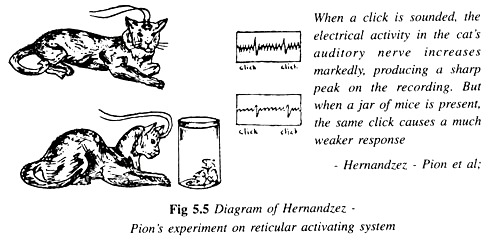ADVERTISEMENTS:
After reading this article you will learn about the functions of Reticular Activating System (RAS).
The Reticular Activating System (RAS) of the brain stem is considered as one of the most important systems which facilitates the functioning of sensation and attention. This is made up of a net-like bundle of neurons that run through the hind-brain, mid-brain and a part of the fore-brain called the hypothalamus. Anatomically this system in man is about the size of the little finger and is located at the core of the brain stem just above the spinal cord and below the thalamus and hypothalamus.
However, selected cells of the RAS are aroused or alerted when signals are being transmitted through sensory input cables from the skin, ear, nose etc. The sensory input cables send their information to specific areas in the cerebral cortex. This is done through specific relay nuclei in the thalamus. On their way, however, these input cables send off collateral branches into the RAS. Within the RAS collaterals from the various sensory channels are intermingled and lack specificity.
The RAS sends its unspecific messages to broad, diffuse areas of the cerebral cortex. Research has indicated that the probable operation of this system is as follows: new sensory information stimulates the RAS, which relays the presence of some kind of stimulation to various sensory receiving areas of the cortex. This diffuse stimulation alerts the cortex, essentially telling it that some kind of news is arriving. The alerted cortex is then better able to deal with or process the specific information arriving over the specific sensory input channel to the cortex.
The alerting function of the RAS has been inferred from the fact that direct electrical stimulation of the RAS will awaken a sleeping cat and produce EEG brain waves characteristic of natural alertness and excitement. If the RAS is destroyed, a profound and enduring coma results and for all practical purposes, the animal is reduced to a sleeping vegetable. Anesthetic drugs that produce unconsciousness appear to act by depressing the RAS.
Thus, the primary function of RAS is to alert the higher brain centres when important messages are received and to filter incoming messages. The eye, for example, sends messages to the brain through the optic nerve. These messages carry the content of the sensory information’s like particular patterns of light waves received by the eye.
The messages from the eye go through the RAS and alert the brain that information is on the way and tell the brain how important the messages are going to be. The filtering process that goes on in the RAS is known as sensory gating. This means that strong sensations from one set of sense organs are allowed to pass, while information from the other sense organs is temporarily held back.
In addition, the system seems to provide some sort of feedback to the sense receptors. It appears to tell them not to send in any conflicting messages (at least for the moment) and to hold all calls until the brain can get around to handling them. The type of information passing through the sensory gates determines where our attention will be directed. For example, sensory messages about a sudden loud noise will pass through, temporarily diverting out attention from the visual sensation involved in reading a book.
The brain, it seems, is able to attend to only one set of messages at a time. It can tune into one and only one channel at any particular moment. This is shown very clearly by the study of (Hernandez Pion and his associates on cats). They implanted electrodes in the auditory nerve of a cat, to find out what happens in the brain when more than one set of sensory organs are stimulated at the same time and how sensory gating takes place. They sounded a click at regular intervals and measured the electrical activity of the cat’s auditory nerve.
Each time the click was sounded the activity of the nerve increased, producing a sharp increase in the recording as shown in Fig.5.5. Then they placed a mouse in front of the cat. As they had expected, the mouse immediately attracted the cat’s attention.
The visual message must have been judged more important and more interesting than the auditory ones, for as long as the mouse was present the sound of click caused a much smaller increase in the electrical activity of the auditory nerve. It was almost as if the cat’s ears were turned deaf. This could be due to the reticular activating system opening the gates to visual sensation and inhibiting the sensitivity of the auditory system.
In recent years the functions of the RAS have received considerable attention especially in connection with the function of arousal. The arousal function has been found to be very much involved in almost all types of human activities.
Perhaps, one may dwell at a greater length on the functioning of the nervous system. We have considered only the limbic system and the reticular system because these are probably more related to psychological processes. In recent years another system known as the vigilance system is being studied. In all probability we will come to know more and more about many other systems of nervous activity which will revolutionaries our approach not only to neural organisation and functioning but to psychology also.
